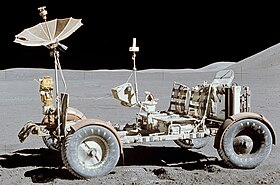
Back Maankarretjie Afrikaans Lunar Roving Vehicle AN العربة القمرية Arabic Ay avtomobili Azerbaijani Месяцавы аўтамабіль Byelorussian Лунар Роувър Bulgarian Lunar Roving Vehicle Catalan Lunar Rover Czech Månebil Danish Lunar Roving Vehicle German
| Lunar Roving Vehicle | |
|---|---|
 | |
| Overview | |
| Manufacturer | |
| Also called |
|
| Designer | |
| Powertrain | |
| Electric motor | Four 0.25-horsepower (0.19 kW) series-wound DC motors |
| Transmission | Four 80:1 harmonic drives |
| Battery | Two silver-oxide, 121 A·h |
| Range | 57 miles (92 km) |
| Dimensions | |
| Wheelbase | 7.5 ft (2.3 m) |
| Length | 10 ft (3.0 m) |
| Height | 3.6 feet (1.1 m) |
| Curb weight |
|
| Chronology | |
| Successor | Lunar Terrain Vehicle |
The Lunar Roving Vehicle (LRV) is a battery-powered four-wheeled rover used on the Moon in the last three missions of the American Apollo program (15, 16, and 17) during 1971 and 1972. It is popularly called the Moon buggy, a play on the term "dune buggy".
Built by Boeing, each LRV has a mass of 462 pounds (210 kg) without payload. It could carry a maximum payload of 970 pounds (440 kg), including two astronauts, equipment, and cargo such as lunar samples, and was designed for a top speed of 6 miles per hour (9.7 km/h), although it achieved a top speed of 11.2 miles per hour (18.0 km/h) on its last mission, Apollo 17.
Each LRV was carried to the Moon folded up in the Lunar Module's Quadrant 1 Bay. After being unpacked, each was driven an average of 30 km, without major incident. These three LRVs remain on the Moon.